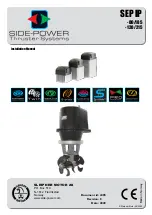
3
Overview of the CompoNet Master Board
Section 1-2
Bit-Level Distribution
CompoNet is connectable with industry-standard e-CON connectors and
Slave Units of clamp terminal-block type. They allow bit-level controls of
conveyors or at warehouses where many sensors are placed over a wide
range.
Data Exchange by Explicit
Messages
Explicit messages are used to access from the PC to the Slave Units and
Repeater Units connected to the CompoNet network. This feature facilitates
the maintenance of the entire network.
Automatic Baud Rate
Detection
By setting the baud rate on the CompoNet Master Board, the Slave Units
automatically detect the baud rate of the CompoNet Master Board and follow
it. There is no need to set the rate individually on the Slave Units.
1-2
Overview of the CompoNet Master Board
CompoNet Master Board is a board that has a mastering function to control
inputs and outputs for the Slave Units connected to the CompoNet network.
The Board is either compatible with PCI bus (Model # 3G8F7-CRM21) or with
CompactPCI bus (Model # 3G8F8-CRM21).
Here are the main features of the CompoNet Master Board:
Control by API Functions
In the Windows operation systems, all functions on the CompoNet Master
Board can be accessed by API functions.
Control by Shared
memory Accesses
In operation systems other than Windows, the CompoNet Master Board is
used via access to shared memory.
Flexible Allocation of the
Number of Connectable
Nodes
The number of connectable nodes can be set differently for each Word Input
Slave Units, Word Output Slave Units, Bit Input Slave Units and Bit Output
Slave Units.
Registration Table
Function to Control
Participating Slave Units
This function is used to pre-register the node addresses and models of Slave
Units that are to participate in the network, and to check whether a Slave Unit
that is actually participating is registered or not. If the Slave Unit is not
registered, it is not allowed to participate. The time can also be set to monitor
duration from power-on until a registered Slave Unit actually participates.
Remote I/O communications can be stopped until all registered Slave Units
participate in the network, but it can be started only with all Slave Units
participating. The latter function is called the All Registered Slave
Participation Standby Mode.
Optimizing
Communications Cycle
When the Registration Table function is used, the communications cycle is
optimized and fastened in accordance with the information in the table.
Synchronous and
Asynchronous Access to
I/O Data
Both synchronous and asynchronous types of access are supported.
Synchronous access maintains synchronicity for each node, while
asynchronous access does not do that but instead provides faster access. In
the latter case, I/O data keeps synchronicity only within the same word.
Other Functions
• Communications Stop Due to Communications Error function
• I/O Communications Manual Startup mode
• IN Data Zero Clear Due to Communications Error function
Содержание 3G8F7-CRM21
Страница 4: ...iv...
Страница 10: ...x TABLE OF CONTENTS...
Страница 30: ...10 Specifications Section 1 7 1 7 3 Dimensions 3G8F7 CRM21 PCI unit mm 3G8F8 CRM21 CompactPCI unit mm...
Страница 46: ...26 Connecting the Communications Power Supply Cables Section 2 4...
Страница 74: ...54 Board Hardware Error Notification Section 4 8...
Страница 173: ...153 APPENDIX D Sample Program D 1 Sample Program 154...
Страница 230: ...210 Wiring for Power Supply Section E 5...
Страница 234: ...214 Index...
Страница 236: ...216 Revision History...
Страница 237: ......














































